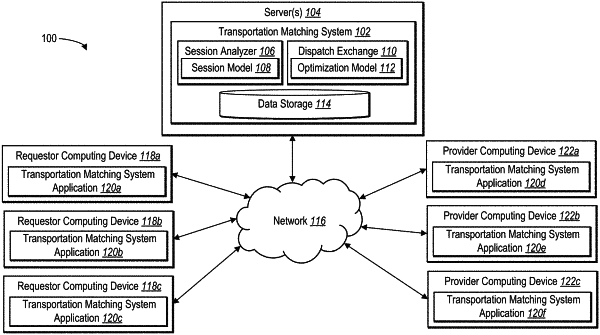| CPC G06Q 10/063114 (2013.01) [G06N 7/01 (2023.01); G06Q 50/30 (2013.01); H04L 67/12 (2013.01); H04L 67/14 (2013.01); H04W 4/40 (2018.02)] | 20 Claims |

|
1. A method comprising:
training a session machine learning model to determine transportation request generation likelihoods based on training data comprising historical pre-transportation request user-initiated application events within a transportation matching system application;
receiving, by one or more servers of a transportation matching system and from a transportation matching system application in an active session on a requestor computing device, a user-initiated application event comprising at least one of a user interface interaction with a pickup location selection element within the transportation matching system application, a user interface interaction with a destination location selection element within the transportation matching system application, or a user interface interaction with a transportation type selection element within the transportation matching system application;
determining, by the one or more servers utilizing the session machine learning model, a likelihood that the requestor computing device will generate a transportation request associated with the active session based on the at least one of the user interface interaction with the pickup location selection element within the transportation matching system application, the user interface interaction with the destination location selection element within the transportation matching system application, or the user interface interaction with the transportation type selection element within the transportation matching system application;
generating, based on the likelihood and prior to receiving the transportation request from the transportation matching system application on the requestor computing device, an upfront dispatch reserving a provider computing device for fulfilling the transportation request;
causing the transportation matching system application on the requestor computing device to display, on the requestor computing device, information associated with the upfront dispatch; and
re-training the session machine learning model based on causing the transportation matching system application on the requestor computing device to display the information associated with the upfront dispatch.
|